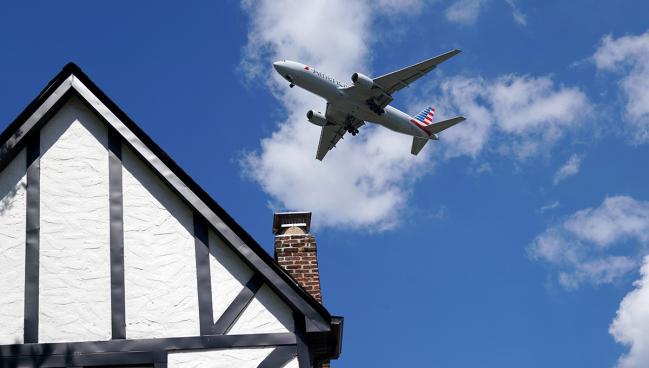Aircraft Noise Exposure Linked to ‘Thicker, Weaker, and Stiffer Hearts’
UK participants who lived by airports or under a flight path had worse cardiac remodeling on CMR than those living elsewhere.

Although the findings show an association rather than causation, the authors say that the exposure to noise likely leads to obesity and hypertension, both known to contribute to worse cardiac remodeling.
“There are some very plausible biological reasons why that could be based on previous experiments, which were conducted in mice and also in humans, where we know that there are clear links between how the body responds to noise pollution—aircraft noise, or just general road, traffic, or railway noise—and the impact that that has on our health,” senior author Gabriella Captur, MD, PhD (University College London, England), told TCTMD.
The effects of environmental factors on heart health have become more apparent in recent years, with studies linking adverse cardiovascular events with everything from temperature swings to air pollution as well as plastic debris. Two review papers published in the Journal of the American College of Cardiology in 2024, for instance, argued for increased awareness of these issues and advocated for increased mitigation efforts within the field of cardiology.
In this study, Captur explained, “people who had been exposed to high levels of aircraft noise were found to have thicker, weaker, and stiffer hearts, and this degree of extra heart muscle thickening on its own basically appears to triple one’s chances of death, heart failure, or stroke.”
We know that there are clear links between how the body responds to noise pollution—aircraft noise, or just general road, traffic, or railway noise—and the impact that that has on our health. Gabriella Captur
Mark Miller, PhD (The University of Edinburgh, Scotland), who served as a lead author on both of the JACC review papers, told TCTMD that the new study adds to the growing evidence that pollution of all kinds deserves more attention within cardiology.
“This important research study provides strong evidence that exposure to aircraft noise stresses the heart to an extent that it can change its structure and function over time,” he told TCTMD in an email. “These changes are likely to increase the risk of serious cardiovascular complications that could lead to irregular heart rhythm, heart failure, or even a fatal heart attack or stroke.”
Additionally, he added, this problem is expected to worsen with time as “exposure to noise is very common and only likely to increase with the world’s greater reliance on transport. Because of this, the cardiovascular effects of noise need to be taken seriously.”
Risk Goes Up, Up, and Away
For the study, published online this week in the Journal of the American College of Cardiology, Constantin-Cristian Topriceanu, MD (University College London), Captur, and colleagues looked at cardiac magnetic resonance imaging (CMR) data from the UK Biobank on 3,635 adults who lived near Heathrow, Gatwick, Birmingham, or Manchester airports.
Using UK Civil Aviation Authority estimates of aircraft noise levels for every 100 square meters, the researchers defined higher aircraft noise as greater than 50 and 45 decibels on average during the day and night, respectively. Notably, these levels are slightly greater than what the World Health Organization recommends during the day (45 decibels) and night (40 decibels). Among the study participants, 8.4% and 2.9% lived in areas with high day and night aircraft noise levels.
After adjusting for age, sex, body mass index (BMI), socioeconomic status, smoking, exercise, and exposure to other pollutants (including road and rail noise), participants who lived in higher aircraft noise areas at night had larger LV volumes, including 5% greater left ventricular end-diastolic volume indexed to height, 7% greater left ventricular end-systolic volume indexed to height, and 7% greater myocardial volume (all P ≤ 0.006). There was also evidence that these people had concentrically thicker hearts and worse LV dynamics.
Based on a separate sample of 21,360 people from the UK Biobank with detailed CMR scans, the researchers estimated that someone with the typical abnormalities associated with higher night-time aircraft noise exposure could have as much as a quadrupled risk of MACE over time.
Findings were similar when looking at daytime noise levels, but “clearest” for night exposure, according to the authors.
BMI seemed to account for 29% to 54% of the observed associations between noise and CMR findings, while hypertension appeared to mediate between 9% and 36% of the associations.
Lastly, the 70% of the study participants who did not move homes between study recruitment and 2022 had an estimated 10% to 20% worse heart structure and function than those who did move out of the area.
Noise pollution is a “pervasive health problem” across the globe, Captur said, but she noted that the value of this study is its ability to isolate the effects of aircraft noise exposure from other noise and air pollutants.
Exposure to noise is very common and only likely to increase with the world’s greater reliance on transport. Mark Miller
There are both individual and societal means to address the risks of noise pollution, she said, suggesting that those who live near airports or under flight paths might be more vigilant about managing other controllable cardiovascular risk factors. “By maintaining a healthy cardiovascular risk profile, modifying the things that we can modify, at least we will be diluting out some of the harmful effects of [the added noise].”
In terms of policy, Captur said that expansion of airports, for example, “has to occur in tandem with policy makers acknowledging this problem and then investing in promising innovations that we know can dramatically reduce air traffic noises, because these innovations do exist and it's just a matter of rolling them out at scale.”
Technologies like satellite-guided flight paths and noise barriers are two such examples, as are restrictions on older, noisier aircraft.
Increasing Awareness
In an accompanying editorial, Thomas Münzel, MD (University Medical Center Mainz, Germany), and colleagues point out that passenger volumes in Europe are expected to increase by almost 50% in the next 15 years. But, they write, “there are currently no regulatory limits on noise exposure in many countries, including Europe and the United States, except the recommendations from the World Health Organization and European Environment Agency, making adherence unlikely.”
Ultimately, Münzel and colleagues say, the study “emphasizes the need for immediate implementation of noise reduction policies to protect us and, in particular, vulnerable populations from the harmful effects of chronic aircraft noise exposure.”
As for how clinicians should respond to this news, Captur said they should be asking about environmental factors with their patients, including noise pollutants, and potentially monitoring blood pressure, exercise levels, and sleep quality more closely.
Increasing awareness should be a focus for clinicians right now, she added. “As we learn more about medicine, and particularly cardiovascular medicine, we are constantly learning about new risk factors for cardiovascular disease,” Captur said. “Up until a few years ago, nobody was really aware that noise pollution itself is an independent risk factor for cardiovascular disease.”
Miller agreed. “We are moving to a stage where people need to be more aware of these possible risks, and physicians have a role in that awareness,” he said.
Yael L. Maxwell is Senior Medical Journalist for TCTMD and Section Editor of TCTMD's Fellows Forum. She served as the inaugural…
Read Full BioSources
Topriceanu C-C, Gong X, Shah M, et al. Higher aircraft noise exposure is linked to worse heart structure and function by cardiovascular MRI. J Am Coll Cardiol. 2025;Epub ahead of print.
Münzel T, Kuntic M, Stamm P, et al. The high stakes of high decibels: the cardiovascular fallout from aircraft noise. J Am Coll Cardiol. 2025;Epub ahead of print.
Disclosures
- The study was funded by the Medical Research Council Aircraft Noise and Cardiovascular Outcomes study grant.
- Topriceanu was supported by a British Cardiovascular Society Heart Research UK Fellowship and by a University College London Charlotte and Yule Bogue Research Fellowship.
- Captur was supported by the British Heart Foundation, a National Institute for Health and Care Research iFAST grant, and by the NIHR UCL Hospitals Biomedical Research Centre.
- Miller reports no relevant conflicts of interest.





Comments